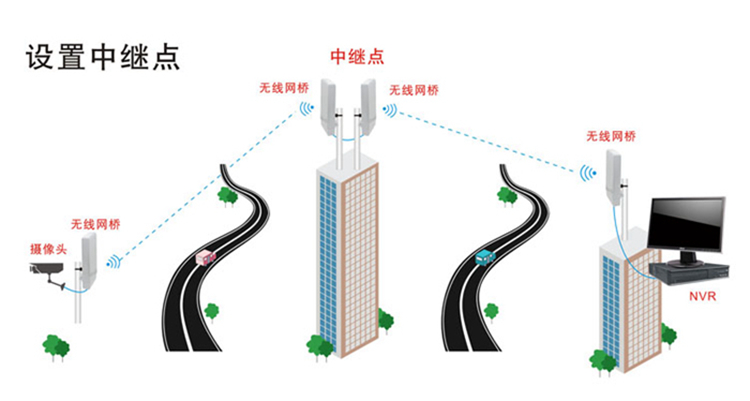The emergence of wireless bridges solves the problem of inconvenient wiring in many scenarios. Among the outdoor remote monitoring requirements, the application of the wireless bridge is more flexible than the traditional wired monitoring, the application cost is lower, and the later maintenance is more convenient. Therefore, wireless bridges are favored among modern remote monitoring requirements. However, wireless bridges use microwaves to transmit signals, so it is inevitable that there will be signal interference in the outdoor. The following small series on the interference of buildings or the interference of similar equipment to popularize the solution for the majority of users.
1. Building interference
When the wireless signal encounters the occlusion of the object during the transmission process, if the signal is not far away from the transmission, the transmission direction will be changed by the way of refraction in the occluded environment, and the reflection and attenuation of the signal will be caused. . Although the signal can be received, the signal strength of the received signal is very weak and the bandwidth is greatly attenuated.
Therefore, when selecting the installation position of the wireless monitoring device, the middle is unobstructed as much as possible, and the transmitting end is visible to the middle of the receiving end, thus avoiding the attenuation of the microwave signal, and the monitoring center can receive the high-intensity wireless signal, thereby improving Monitor the effect. If there is occlusion between the transmitting end and the receiving end but there is no way to avoid it, we can avoid the middle obstruction by means of a raised device or a relay.
2. Interference from similar equipment
Similar devices have more interference, such as bridges of the same frequency, signal sources in the system, power supplies, etc. For this case, you can adjust the frequency of the wireless device, select a clean channel, or change the transmitter or receiver of the wireless device. Position the device and pull the distance between the devices.
How to judge whether the bridge receives interference, you can judge through the monitoring screen, if there is packet loss, picture instability, clutter, black stripes, ripples, etc. If there is any indication that the device is interfered, you need to find the cause one by one. .
Not all devices interfere with wireless, such as mobile, Unicom towers, walkie-talkies, wireless, etc., which have no impact on wireless microwave devices. In the case of interference sources, the frequency of the device can be adjusted, or it can be installed at a location far from the interference source, thus greatly reducing the interference to the wireless microwave device.
As a professional wireless bridge supplier in the industry, Tengyuan Zhituo has 13 years of experience in the stable transmission of wireless bridges. Every wireless bridge of the company has very strong anti-interference and it is worthy of your peace of mind.
Welding Rod
Tubular tungsten carbide welding rods are a type of welding consumable used for hardfacing applications. They are made by filling a tubular steel rod with a mixture of tungsten carbide particles and a binder material.
The tungsten carbide particles provide exceptional hardness and wear resistance, making them suitable for applications where the welded surface needs to withstand high levels of abrasion, erosion, or impact. The binder material helps to hold the tungsten carbide particles together and facilitate the welding process.
Tubular tungsten carbide welding rods are typically used in industries such as mining, construction, oil and gas, and agriculture, where equipment and machinery are subjected to harsh operating conditions. They can be used for hardfacing various components, such as drill bits, crusher hammers, wear plates, and cutting tools.
The welding process for tubular tungsten carbide rods is similar to other types of welding, such as shielded metal arc welding (SMAW) or gas tungsten arc welding (GTAW). The rods are typically welded using a high heat source, such as an electric arc, to melt the rod and create a strong bond with the base metal.
Overall, tubular tungsten carbide welding rods are a popular choice for hardfacing applications due to their exceptional hardness and wear resistance properties. They help extend the lifespan of equipment and machinery, reducing maintenance costs and downtime.
Welding Rod,Welding Rod Price,Best Welding Rods,Tungsten Welding Rod
Luoyang Golden Egret Geotools Co., Ltd , https://www.xtcmetalpowder.com

